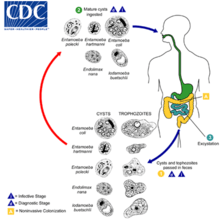Entamoeba polecki
Entamoeba polecki is an intestinal parasite[1] of the genus Entamoeba. E. polecki is found primarily in pigs and monkeys and is largely considered non-pathogenic in humans, although there have been some reports regarding symptomatic infections of humans.[2] Prevalence is concentrated in New Guinea, with distribution also recorded in areas of southeast Asia, France, and the United States.[3]
| Entamoeba polecki | |
|---|---|
| Scientific classification | |
| (unranked): | |
| Subphylum: | |
| Class: | |
| Family: | |
| Genus: | |
| Species: | E. polecki |
| Binomial name | |
| Entamoeba polecki von Prowazek, 1912 | |
Morphology
Mature trophozoites of E. polecki are generally 10-20 μm in diameter. Trophozoites are irregularly shaped and possess pseudopodia for motility.[3] They have a single nucleus with a small central karyosome and finely dispersed peripheral chromatin, similar to that of Entamoeba histolytica[3]. Cytoplasmic contents are similar to other Entamoeba sp. and are usually granular and vacuolated.[3] Cysts of E. polecki are morphologically unique, containing only one nucleus, varyingly sized chromatoid bars, and a large inclusion mass.[3][4]

Transmission & Life Cycle
There are two stages in the life cycle of E. polecki.[2] The first is as a trophozoite, a vegetative stage that cannot survive in the environment.[2] The second is a cyst, where transmission of parasite is possible and provides protection to harsh external environments. Cysts are infective when ingested by another organism.[2] The cystic form of this protozoan has a diameter as small as 9.5 µm and as large as 17.5 µm. Morphologically, E. polecki is extremely similar to Entamoeba histolytica and Entamoeba hartmanni. [2]
Transmission follows a fecal-oral route. Infected feces with mature cysts are ingested where the cyst matures to the trophozoite in the gastrointestinal tract of the host. It is considered to be a zoonotic parasite, as close contact with infected swine have been reported to be the cause of E. polecki infections in humans.[5] Transmission to humans from consumption of pork is unlikely.[6] Recent studies suggest that different subspecies infect non-human primates and pigs, and close inhabitation between the two do not coincide with transmission.[7]
Pathology
E. polecki is considered to be non-pathogenic in humans. Nonspecific symptoms from infection have been reported, including nausea, vomiting, diarrhea, bloody stools, and fever.[8][5] Prevalence of infection amongst swine may be up to 25% across the world, but tend to be asymptomatic.[5]
Diagnosis and Treatment
Examination of stool samples for uninucleated cysts and trophozoites have been used for diagnosis.[8] This method is not always reliable due to morphological similarities between E. polecki and other Entamoeba species.[8][5] More recent diagnostic methods utilizing DNA amplification and comparison have been used to better differentiate amongst pathogenic and species such as E. histolytica and non-pathogenic species.[5] A definitive diagnosis can be made by using electroimmunotransfer blots.[2] Serological testing is not accurate between species of Entamoeba.[2]
Treatment of infection is similar to that of other Entamoeba infections. Anti-parasitic medications such as metronidazole and ornidazole are generally used to treat human infections.[3] Combination therapies such as metronidazole and diloxanide furoate have been effective as well.[5]
References
- Iran J Parasitol: Vol. 10, No. 2, Apr -Jun 2015, pp.146-156
- "Entamoeba Polecki". web.stanford.edu. Retrieved 2018-03-24.
- A., Gockel-Blessing, Elizabeth (2013). Clinical parasitology : a practical approach (2nd ed.). St. Louis, Mo.: Elsevier Saunders. ISBN 9781416060444. OCLC 816557145.
- 1935-, Roberts, Larry S. (2005). Gerald D. Schmidt & Larry S. Roberts' foundations of parasitology. Janovy, John, Jr., 1937- (7th ed.). Boston: McGraw-Hill. ISBN 978-0072348989. OCLC 54400427.CS1 maint: numeric names: authors list (link)
- Solaymani-Mohammadi, S.; Petri, W.A. (2006). "Zoonotic implications of the swine-transmitted protozoal infections". Veterinary Parasitology. 140 (3–4): 189–203. doi:10.1016/j.vetpar.2006.05.012. PMID 16828229.
- Djurković-Djaković, O.; Bobić, B.; Nikolić, A.; Klun, I.; Dupouy-Camet, J. (2013). "Pork as a source of human parasitic infection". Clinical Microbiology and Infection. 19 (7): 586–594. doi:10.1111/1469-0691.12162. PMID 23402388.
- Tuda, Josef; Feng, Meng; Imada, Mihoko; Kobayashi, Seiki; Cheng, Xunjia; Tachibana, Hiroshi (2016-09-01). "Identification ofEntamoeba poleckiwith Unique 18S rRNA Gene Sequences from Celebes Crested Macaques and Pigs in Tangkoko Nature Reserve, North Sulawesi, Indonesia". Journal of Eukaryotic Microbiology. 63 (5): 572–577. doi:10.1111/jeu.12304. ISSN 1550-7408. PMID 26861809.
- J., Magill, Alan (2012). Hunter's tropical medicine and emerging infectious disease. Strickland, G. Thomas., Maguire, James H., Ryan, Edward T., Solomon, Tom. (9th ed.). London: Elsevier Health Sciences. ISBN 9781416043904. OCLC 861539914.
- Cook R. Entamoeba Polecki [Internet]. Web.stanford.edu. 2004 [cited 23 March 2018]. Available from: https://web.stanford.edu/group/parasites/ParaSites2004/Entamoeba/Entamoeba%20Polecki.htm